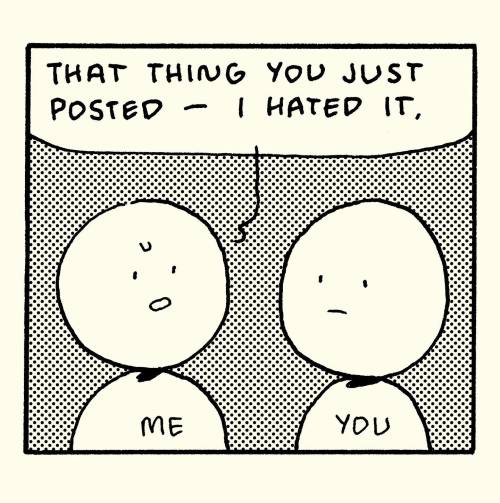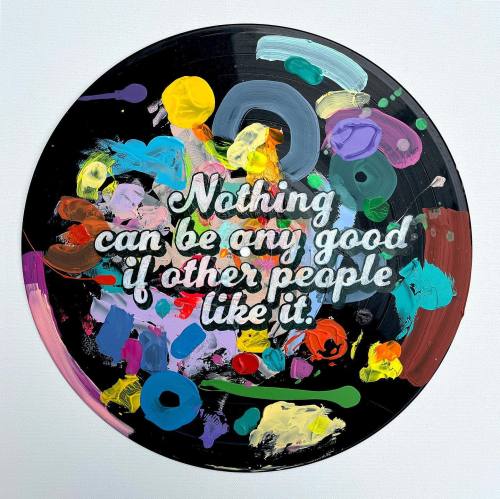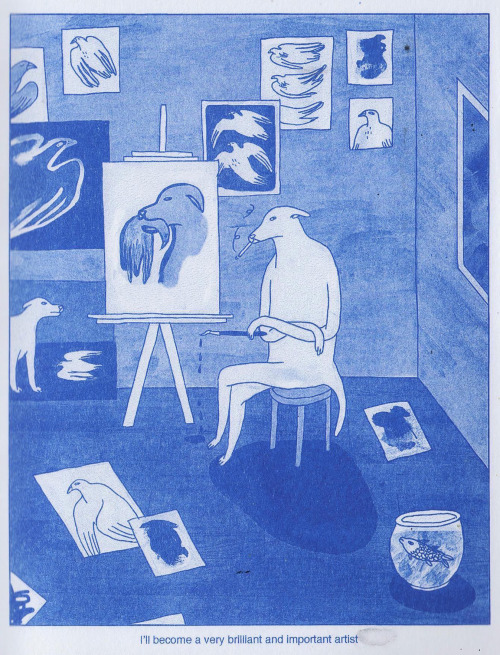HELLO EVERYONE HELLO!
I did what I am reasonably certain is my last bit of work before Christmas yesterday – call me Stakhanov! – and as such it’s frankly a miracle I could be bothered to drag myself from my pit at 6am this morning to spaff this out. THANK ME! BE GRATEFUL!
Ahem.
I appreciate that for those of you with more conventional approaches to ‘having a career’ there may be a few more weeks of desultory, pointless ‘work’ to get through before you get to spend a fortnight fois gras-ing yourself with Celebrations, though, so consider this week’s edition a thankyou for all your hard work making presentations or whatever it is that you all do.
I am still Matt, this is still Web Curios, and you are a brilliant and special team member who adds real value every single day, and don’t let ANYONE tell you otherwise.

THE SECTION WHICH IS AT LEAST RELIEVED THAT TIME DIDN’T TRY AND MAKE CHATGPT ITS PERSON OF THE YEAR, PT.1:
- Google Gemini: AN EXCITING NEW ERA OF AI IS UPON US! Except it isn’t really, not yet, given that the fancy multimodal stuff being shown off in the demo video (click the link, watch the video be impressed! Go on, I’ll wait) is Google’s top-end ‘Ultra’ model, and that’s not launching at all til ‘some time in 2024’ – still, the functionality on display in the demo is quite remarkable, with The Machine apparently able to parse information from video in realtime, make assessments and assertions and assumptions from multiple input types, and generally taking a pretty big step towards ‘being incredibly fcuking useful, to a degree that is increasingly-creepy’. BUT, to reiterate, the fancy stuff isn’t live yet – the version of Gemini that you CAN currently play with is limited to the mid-level version that they have plugged into Bard, which still isn’t as good as paid-tier GPT4, so tbh this is still all a bit ‘jam tomorrow’. Nonetheless, it’s an interesting glimpse into the NEXT WAVE of all this stuff, set to arrive in the next twelve months or so, and of some of the potential ways in which the multimodality of the coming set of models might be employed. If you’re interested you can read one of the (many) puff-piece interviews that Demis Hassabis did around the launch in which he explains a bit about the model’s capabilities and performance relative to existing benchmarks, and this is a blogpost from Google which talks you through what you can see in the demo video and what the machine is doing at each point…and this is a blogpost from Gary Marcus in which he rather grumpily points out that you should never, ever take demo videos like this at face value, and he is of course right which is why I am going to stop doing Google’s PR for them now.
- Shopping Muse: I’ve been continually surprised this year by the lack of actual, honest-to-goodness branded uses of generative AI (I mean, I say ‘continually’ – I promise that I do in fact have other things to occupy my mind than ‘WHITHER THE AI BRAND ACTIVATIONS????’), but, as we til back the bottle and suck down the very dregs of 2023, here one comes! Shopping Muse is…I mean, look, it’s a sales assistant chatbot, let’s not beat around the bush here, but it’s been developed by Mastercard (or at least a certain bit of the Mastercard business – I’ll be honest, I can’t really be fcuked to untangle the bizarrely-byzantine brand relationships here) as part of its digital sales solutions, and it sells itself as an off-the-shelf product which any retailer can plug into the backend of their website to act as a FRIENDLY CONVERSATIONAL SALES AI – but, you know, a GOOD one, not like those sh1tty Facebook chatbots that your agency sold you in 2013 telling you they were the future of customer service. I’m curious about this and at what point we’ll see it integrated into actual digital storefronts – it’s in early-access at the moment, so expect to start ‘enjoying’ your interactions with AI salespeople at some point in Q224.
- Animate Anyone: That reads more like an exhortation than I’m strictly comfortable with – to be clear, I do not believe that you should just go ahead and ‘animate anyone’. Still, the tools now exist to do that very thing – you may have seen a spate of new ‘animated stills’ doing the rounds this week, and it feels inevitable that this tech is going to be in lots of people’s hands before too long, so best get used to it! The main link here takes you to a paper published by Alibaba, which demonstrates a new technique they’ve developed to apply motion to still images; specifically, dancing motion (which you may not be wholly surprised to learn has been effectively stolen wholesale from thousands upon thousands of TikTok videos) – so, as you can see from the on-page examples, it’s now totally possible to take a photo of anyone and marionette them into capering like a moron for your own enjoyment! This isn’t wholly new, but the degree to which the software is able to ‘fill in’ the frames by ‘imagining’ what should be there is hugely impressive – when you see clips of this stuff on a small screen, in motion, unless you really pay close attention to the details it’s pretty hard to spot that it’s The Machine at work. Which is fine, until the point at which you stop to think and then realise that this is INEVITABLY going to be used to…yes, that’s right, CREATE MORE BONGO! Oh, come on, don’t look at me like that, we all know that that’s what all the messageboard weirdos are going to be spending their GPU time on, let’s not pretend. Still, let’s pretend for a moment that it WON’T end up being used to meatpuppet women into uncomfortable-looking situations and that instead it’ll just be a fun, benign toy which children use to create dance troupes from their toys or something – better? Good! You can have a play with a similar tool here, should you be interested, but DON’T DO ANYTHING WEIRD WITH IT.
- Imaginary AI Travel: I really enjoyed this project by Lynn Cherny which uses data from Google Maps combined with some LLM wrangling to produce imaginary travelogues to different cities. “The basic idea is that I start with a vacation at a string location, like “London Bridge, London, England,” and a value of money. The amount of money determines how long I stay there. Each day, I visit sites and restaurants, take pictures, and post in my journal and on social media about what I did/saw. I have a randomly chosen “reason” for being there which affects the text generation.” The link here takes you to a Github page collating the outputs, along with an explanation by Lynn about some of the mechanical aspects of the project – click through and enjoy an entirely-imaginary trip to Berlin, or Venice, or Iceland! There’s something about this that tickles part of my brain – there are SO many ways in which you could take this premise, and I have just lost about three minutes daydreaming about a system that would let you send AI ‘tourists’ out into the world to go exploring and then send you daily postcards about what they have ‘found’ so, er, that’s nice.
- Meta Image Generation: You’ll need a VPN set to the US to try this, but Meta quietly launched its standalone Dall-E-esque image generation tool, offering a web-based interface for all the image AI stuff that they are now starting to roll out into Facebook, Messenger and Insta. The model is fine – from a cursory play I’d say it’s slightly less good than the latest iteration of Dall-E you can use through GPT or Bing – but I present it more as a curiosity than something you ABSOLUTELY MUST USE. Fwiw I wasn’t able to get it to generate anything copyright-bothering or horrible, which is unsurprising but still a bit disappointing tbh.
- Bitmagic: You know the caveat I put in the Google Gemini writeup about how you should never, ever believe product demo videos? Bear that in mind when you click this link, because what these people appear to be selling is jaw-dropping and almost certainly won’t work anywhere near as well in practice. Bitmagic is a VERY early-access platform which is basically pitching itself as ‘generative AI for games that lets you literally imagine ANYTHING and spin it into a gameworld within seconds, on the fly’. Which, I know, sounds MAD – but click the link and watch the trailer and prepare to be amazed. “All you need is your imagination and Bitmagic helps you create the game you want to make. Describe the experience and within seconds you have a rich game world with a story and quests. The beauty of it is, anyone can create, and we mean anyone! No matter what language you speak, you can imagine and create. When you have made the game you want, play it and share it. With anyone, anywhere at anytime” – so runs the blurb, and when you see castles and dragons and trees and hills and lakes just sort of *pop* into being in the demo video it does rather seem like magic. Of course, making games is significantly more complex than just plonking some character models into an environment – which is where my skepticism begins, because there’s very little detail about all the important stuff in the demo video, stuff like ‘creating relationships and dependencies between objects’ and ‘behaviour parameters’ and ‘pathfinding’ and ‘hitboxes’…still, let’s suspend our disbelief and just imagine that, yes, in the soon-to-come digital future we will just be able to imagine gameworlds into existence and things like ‘waiting a decade for the next GTA to come out’ will be nothing but distant memories. Although, obviously, if you work in game design you might want to maybe not imagine that at all.
- I Didn’t Ask For This: Do you live in a city which has been ‘blessed’ with ebikes? Do you enjoy your quotidian steeplechase as you clamber through, over and occasionally under the piles of abandoned velocipedes littering the pavements? Have you ever found yourself cursing the faceless venture capitalist fcuks whose cashspaffing has resulted in piles of massive, heavy, unwieldy plastic-and-metal bikes clogging up urban centres from Amsterdam to Zurich? GREAT! In which case you might be interested in this project by Fred Wordie – stickers (available to buy or to print on demand) featuring a small QR code designed to be affixed to any stray, abandoned ebike you might find and which, Wordie hopes, will make people curious enough to scan said code and be taken to one of a selection of websites which will explain why it might be a nice idea to, you know, not pollute our urban environment with thousands of these bstard things. Yes, ok, this is possibly a *bit* pass-agg, but come on, you fcuking hate them too, don’t lie.
- The Meataverse: I know, I know, you don’t feel the need to spend additional desultory minutes of your already-disappointing life trudging bleakly around a corporate digital space calling itself a ‘metaverse’ – but wait! Come back! What if I were to tell you that there is a metaverse dedicated to DELICIOUS PARMA HAM? One in which you can, er, wander round a DELICIOUS PARMA HAM-THEMED DIGITAL WORLD? Who wouldn’t jump at the chance to guide their avatar through a digital recreation of a salumeria? NO FCUKER, etc! This is quite, quite marvellous – I don’t really understand exactly what purpose it serves (IT IS THE METAVERSE, MATT, ITS EXISTENCE IS ITS OWN PURPOSE FFS), or indeed why anyone thought that this is better than JUST HAVING A FCUKING WEBSITE FFS, but I am so so so glad that it exists. I can’t stress enough quite how…weird the whole thing is, and how incredibly unappealing and oddly-visceral the room full of digital hams is (I am not joking – there really is an ‘ageing’ room in the MEATIVERSE, in which you can stroll your digital self through 50-odd hams hanging from the digital ceiling. Again, WHY????? God this is wonderful (found via Pietro Minto’s excellent newsletter).
- The Happiverse: CLICK THE LINK AND FEEL ‘HAPPI’! Would you like to navigate a slightly-floaty-feeling character through an ‘interpretation’ of the Louvre which doesn’t really seem to have anything to do with the actual museum beyond the courtyard? Would you like to COLLECT PETALS for some unspecified eventual reward? Well aren’t YOU in for a treat! Thanks to Lancome, who have been fleeced to a not-inconsiderable degree by some digital salespeople, you can do that very thing! In fairness the graphics here are rather nice but, again, WHY???!?!?! Also, not really sure what the Louvre is getting out of this partnership here. Still, COLLECT THE DIGITAL PETALS!! If anyone can explain to me the link between this pointless piece of digital shovelware and the broad concept of ‘happiness’ then I would be grateful, thanks.
- Hacker News On Your Wall: I couldn’t give less of a sh1t about having Hacker News headlines on my wall, but I ADORE the concept behind this – to quote: “Step 1: Data Fetching. Every four hours, our scheduler fetches the top stories from Hacker News. Step 2: Image Generation. For the top story, we combine the title of the post with a specific prompt (“high-contrast black-and-white digital illustration suitable for an eInk display, digital art, trending on ArtStation”) and pass this to a Google Cloud Function. This function interacts with the Stability AI REST API to generate a base64 encoded image. The result? A stunning visual that’s perfect for an E Ink display. Step 3: Text Summarization. We then extract the plain text from the story’s URL and feed it to the GPT-3.5-turbo-16k model with a system prompt tailored for hacker-centric insights: “Summarize the key points in the following text in max 3 sentences as if you’re the author.”” I WANT ONE OF THESE SO MUCH. SO MUCH. Except, I don’t know, pointed at Reddit or something.
- No Bullsh1t Games: A potentially useful resource, this – a site which attempts to collate recommendations for mobile games that are actually good, and which don’t try and gouge players with an endless stream of predatory microtransactions.
- Cinemorgue: Do you have a strange and possibly-unhealthy obsession with onscreen death? OH GOOD! “Cinemorgue Wiki is an encyclopedia that is dedicated to documenting which actors or actresses “died” in which movie or TV show. Having started as a separate website, the documentation effort proved to be too big a job for one person, so the wiki was born where everyone is allowed to submit their additions and corrections directly. So if you’ve ever wondered “Has so-and-so ever done a death scene?” or “What’s that movie where what’sisname kills such-and-such?”, then this index will strive to answer those questions.”” The section where you can sort by ‘cause of death’ is particularly…well, unpleasant, frankly, although it’s good to know that there’s a place where I can explore exactly which films contain representations of death by cardiac embolism.
- Wrapped Worldwide: Loathe as I am to give more publicity to Spotify in a week in which they canned a bunch of staff, but I found this additional layer to their annual ‘wrapped’ stunt quite interesting – here you can look at the top wrapped tracks across a range of countries, so you can get a feel for what is big in various (for example) South American or European countries. The South American lists in particular fascinated me – the fact that Feid makes up 60% of all the picks across the whole continent despite having literally no profile whatsoever in Europe (or at least no profile that I have spotted, which admittedly means very little – I am a 44 year old man, I am probably not quite ‘target demographic’) is slightly-mindblowing to me.
- International Wedding Photographer of the Year: I am including this link almost exclusively in the hope that one of you is getting married in the next 12 months and will use the images in this selection to TORTURE your wedding photographer with increasingly-insane demands and expectations. Don’t let me down! Also, invite me! I was thinking the other day that I’m unlikely to attend many more weddings in my life, and that made me a bit sad, so if you fancy inviting a strange misanthrope to your nuptials then, well, just ask!

By Ed Mell
THE SECTION WHICH IS AT LEAST RELIEVED THAT TIME DIDN’T TRY AND MAKE CHATGPT ITS PERSON OF THE YEAR, PT.2:
- I Thought About That A Lot: Via my friend Rishi comes this lovely site, now in its third year, I Though About That A Lot presents one essay a day throughout December, each by a different anonymous author, addressing a topic or theme that has occupied their mind over the past 12 months. You can subscribe to receive each day’s essay via email or just check in here when you remember and catch up on the writings – essays for 2023 so far cover “my employer’s BS approach to diversity and inclusion, choices, caregiving and my love life, money, my Abaji, the greatest storyteller and listener, my inner child, the friend who’s sad I’m single” and there’s something particularly-lovely about the anonymity of the voices and the breadth of thought and experience that emerges through the curation (and, even better, you can go back and read all the previous years’ essays as well).
- Plant: Via Andy comes this rather wonderful digital toy which lets you CREATE PLANTS via the magical medium of a few sliders – fiddle with the various parameters (leaf curvature, gravity, etc – it’s complicated, but there are tutorials for the curious amongst you) and see as your imaginary flora comes to life; I presume that there’s some practical purpose to this, but I’m fcuked if I know what it is, so I’m choosing to view it as a sort of God simulator – you can also download the models should you wish to, I don’t know, create your own virtual greenhouse full of terrifying triffids of your own wild imaginings.
- Stampfans: This is sort-of silly but equally I FCUKING LOVE IT – Stampfans is a newsletter platform taken to its logical-if-ridiculous extreme, meaning that it sends them as ACTUAL LETTERS; you write your newsletter as per, and rather than being delivered digitally to inboxes it will instead be mailed to them as an ACTUAL PHYSICAL LETTER! As far as I can tell there’s no fee to publish on the platform – writers set their own subscription price, with the average seeming to be around $5 a month (with 12 letters sent a year) and the platform presumably taking a cut. There don’t seem to be LOADS of people signed up as authors, and I’m not wholly convinced that anyone is really DESPERATE to sign up to receive printed newsletter content – but I am willing to accept I am wrong, and as such if anyone feels like their life would be improved by receiving Curios in physical, printed form (18 pages of A4 and you can’t click anything!) then, well, let me know.
- Superbritanico: I can’t quite recall how I stumbled across this, but Superbritanico is a Spanish shop for anglophiles and…wow, is this a very specific and very, very twee idea of England that’s being sold here! I can’t for a second imagine that any of you will be rushing to buy anything from this site – I don’t envisage there being a *huge* Venn diagram overlap between ‘people who like Curios’ and ‘people who want to buy a Harry Potter-themed tshirt that reads ‘Not Today Dolores’ – but there’s always something interesting about seeing your own country’s culture through another culture’s eyes. I think anyone who actually lives in 2023 England will find the general vibe of this whole site darkly funny – it has very strong ‘God wasn’t the 2012 opening ceremony of the Olympics the high point of recent history?’ and #FBPE energy, basically (but, er, Spanish).
- Sausages: Wikipedia provides again, with this stellar entry on the sausages of the world – I really, really want someone to make it their life’s project to eat every single one of these and document the process as some sort of performance art, so if any of you fancy making my dreams a reality then, well, thanks! Also, apparently there is a type of sausage available in the US called ‘lebanon bologna’ which I think might be the most satisfying combination of words I have heard all year – seriously, just say it out loud to yourself, isn’t the meter and cadence just PERFECT? Lovely, offaly poetry.
- Subaru’s Badge of Ownership: I’ve always been interested in the Subaru brand in the US, ever since I read a great article about how the car became the unofficial vehicle of American (and subsequently global) lesbians and I am intrigued by this new campaign they’ve launched in the US recently – Subaru owners can apply to get a free additional badge for their car which lets people proudly display how many Subarus they’ve owned and all the things they are into, from photography to kayaking to, er, ‘love’, like some sort of weird vehicular riff on the San Francisco hanky code. Is this because Subaru owners love sharing their passions and enthusiasms? Is it a dating thing? Is there a companion site to this one which decodes all the 33 possible ‘lifestyle badge’ choices and explains exactly what they mean IRL? If I proudly support a badge declaring me as being ‘into birdwatching’ does that mean I am in fact advertising my availability for some sort of unpleasantly-soapy gangbang? I HAVE NO IDEA, but I was momentarily amused by imagining a series of ‘alternative’ badges that one might get, advertising one’s love of, say, fags and superlager and figging, and I would quite like someone to do a ripoff version of this with more of a ‘Viz’-type vibe.
- Trains: Specifically, American trains RIGHT NOW – this is a realtime map of the US rail network which updates each minute to display the positions of trains across North America. Via Giuseppe, this is largely-pointless (at least for me, a man currently sitting at a desk in North London) but it’s slightly-astonishing (and frankly a bit shameful) to see how few trains there actually are in a country the size of the States.
- The Sphere: While the London Sphere currently exists in a state of planning limbo (but, please God, is unlikely to ever actually be built) you can if you desire experiment with your very own miniature version; click the link and select from one of a series of presets to see what The Sphere might look like with, say, a giant emoji face on it; or, if you’re of sufficient coding ability, modify the code to make it display whatever you like. I quite like the idea of having this on a huge screen, cycling through various awful options stretched across the horrid LED canvas – one for the office reception area, maybe.
- Blue Donut: Sometimes the links in Curios are rabbitholes, opening up into entire worlds you never knew existed into which you’re invited to get lost and explore; sometimes they are to a single rotating image of a blue donut, floating in space for reasons I am unable to discern. Guess which this one is.
- Infinite Flowers: This feels like an incredible throwback of sorts – do you remember the Zoomquilt? OF COURSE YOU DO! Anyway, this is basically like that, but rather than taking you through an infinitely-zooming selection of fantasy scenes like the original did, this instead gives you a seemingly-neverending zoom into a pastoral scene. This is possibly the most hypnotic and oddly-relaxing site I’ve seen all year, and to be honest it’s all I can do not to just down tools right now and stare at it like a slack-jawed and drooling idiot, but just for you I will resist. Via the ever-essential Naive Weekly, this one.
- Sonic Garbage: Oh this is SUCH a fun little musical toy! I think the best way to describe it is as a beat/loop maker in which all the sounds are clips/samples from across the web, so you’re effectively collaging beats together out of fragments of dialogue and sound effects and the like; all of this is presented in a simple-looking interface which, if you read the associated documentation, you will quickly realise is significantly more flexible and powerful than you might expect, and which will let you do all sorts of interesting things with the volume and pitch and speed of various samples, locking and looping and generally letting you cobble together stuff that sounds a *bit* like a really sh1t version of The Avalanches (that’s my experience, but I hold out hope that some of you will be significantly more talented than me and will be able to make BEAUTIFUL MUSIC with this). SO much fun, this – if nothing else you can use it as a really excellent soundboard to punctuate your next presentation with (please please can one of you do this? Thanks).
- The Backyard: Another one from Naive, this is by Martin Schotten who writes: “I’ve built this little backyard to my website, because every website should have a garden, a backyard, a basement, or any other wild space. Treated with lovely care it grows various experiments in a natural, playful, hypertext way…The backyard is outside and full of stuff worth discovering. There is no sitemap or index — you can follow various hyperlinks to other parts of the backyard on each page. In case you got lost, you will always find a link back to this door at the bottom left of each page.” I LOVE THIS – this is mysterious and curious and ODD and sort-of pointless and I think every single website made from hereon in should have its own ‘backyard’. Seriously, how much better would your tedious, identikit agency website be if it had a secret area full of ODD THINGS which people could stumble upon unawares? It would be 58% better, fyi.
- The Commons Library: This is a great idea and a useful resource for anyone interested in activism and campaigning: “The Commons library is the ‘go to portal’ for social change resources. We gather and share resources from many different sources and organisations from all around the world in a user friendly, accessible portal. We also create resources to help change makers stop reinventing the wheel and support them with what they need. The Commons works in partnership and provides customised services to organisations and networks engaged in social change activities. This includes collating resource kits, hosting collections, developing curriculum, writing case studies, researching issues and building new resource libraries.” It’s an Australian initiative but collects resources from all over the place, so if you or anyone you know is looking for resources to help you start campaigning on an issue then this is a decent place to begin looking.
- Eyes on the Earth: This is an amazing website by NASA, sharing near-realtime data about the surface of the planet – you can select the data you’d like displayed and then see the globe change to show, say, average air temperature, or sea levels or levels of nitrous oxide, although you might want to ignore the title of the model which is called ‘Vital Signs of the Planet and which if you think about it too hard might give you The Fear. Still, look at all the pretty colours (don’t think about what they mean)!
- Suns Explorer: Ooh, I do like an unusual dataviz – Suns Explorer is a project which takes a novel approach to displaying the collection of the Harvard Art Museum: “In Suns Explorer, each group of concentric circles represents an artwork. The colors and behavior are set by the data that describe the work. For example, the time it takes each work to move across the screen is based on the total number of times that object’s page has been viewed on the museums’ public website since 2009—the slower the pace, the more popular the artwork. Use the controller to play with the suns, or take a moment and enjoy the beauty of data.” I really like this, not least because there’s something pleasingly oblique and slightly-whimsical about the interface which encourages the user to think of the collection through different lenses than they might ordinarily have done.
- Mangosteen: What’s your favourite fruit? Yeah, ok, fine, but does it have its own dot com domain dedicated to celebrating it? NO IT FCUKING DOES NOT AND THAT IS WHY THE MANGOSTEEN IS THE BEST FRUIT! This is a very old website but I am in love – it even has a dedication at the top, which is SO LOVELY: “This site is dedicated to Ed Kraujalis, “the mangosteen man.” To all who knew him and loved him, he left us all long before his time and long before any of us could believe it. His devotion to the mangosteen fruit and the awareness of its charms meant our paths would cross years ago. I will always be grateful for his patience and earnestness and willingness to provide me with any help he could to help me bring the mangosteen out into the light of day. I think of him every time I am on my farm and see many of the older trees that were from “the mangosteen man.” In this way, he is still with us and will be for many years to come.” Seriously, is your heart not warm? Are your eyes not damp? Anyway, if you want mangosteen-related information then this site is your friend.
- Random 90s Bands From London & NYC: Ok, that’s not technically the name of the YouTube channel, but it ought to be – this is a collection of videos put online by Rick’s Music Archives, a shop which seems to exist to sell expensive DVDs of concert footage of bands you have never heard of playing a selection of small music venues in London and New York in the 90s and early-00s. Would you like to own a copy of Renton’s SEMINAL set at the Bull & Last from 2001? Well GREAT, Rick’s got you covered! The YouTube channel presents individual tracks from these VITALLY IMPORTANT moments in musical history, and there’s a quite astonishing quantity of live tracks, most of them with no views at all. If you’re a connoisseur of the live music scene at the turn of the millennium, or if you happened to be in a band that did three gigs in 2003 at the 12 Bar Club and you want to find the only extant footage of your appalling drunken bass playing, this is the YouTube channel for YOU.
- The Oluk: This is the website of Manuele Saviantoni, a pixel artist and game designer who makes a LOT of actually pretty fun 8-bit-style promo games for brands, and who has helpfully provided links to ALL of them from his homepage – if you fancy wasting a few hours playing a selection of really-nicely-designed minigames then you could do worse than click this link and go exploring (and I want to take this opportunity to once again point out that GAMES MAKE GREAT PROMO CONTENT and suggest that perhaps you might want to book this man because he makes Good Stuff).
- Noun Noun: Oh this is GREAT – “You know when a word’s on the tip of your tongue but you can’t quite remember it. But you can sort of describe it. This is a game about guessing that word through those other words.” Hand shoes? GLOVES! Flutter mouse? BAT! This is oddly akin to the experience of being very, very hungover, to my mind at least.
- The Ultimate: Finally this week, a VERY VIOLENT and quite unpleasant little top-down shooter which is basically ‘Hotline Miami, but in the browser and without anything resembling a storyline’. You are a nameless avatar whose goal is, simply, to kill everyone on each level. That’s it. There’s some gentle window dressing about how the people you’re offing are Nazis and so therefore it’s ok that you’re redecorating the walls with their viscera, but, honestly, this is just sort of brutal and nihilistic and ugly. It’s also REALLY REALLY FUN (sorry, but it is) and VERY HARD, and I have spent about an hour with it this week, on and off, and can recommend it unreservedly. There’s a roguelike element to it, with enemies and weapons spawning in new locations each time you play, and it’s fast and bloody and frustrating and SUPREMELY CATHARTIC. Also the themetune bangs.

By Kevin Huizenga (NB – You should save the above image to your phone and, once a week, send it at random to someone in your contacts, just to fcuk with them)
THE CIRCUS OF TUMBLRS!
- Every Chip Stand: Not in any way a Tumblr! Still, this is a lovely project celebrating the chip stands of Ontario through lovely little illustrations; chip stands are a regionally-specific THING, you see! From the ‘About’ page: “Chip stands are a ubiquitous part of Ontario’s landscape. Most chip stands began as a vehicle of some sort that morphed into a semi-permanent,retrofitted, DIYed shack. They are not pretty, nor do they pretend to be. They are not pristine eateries; you will be eating your food on the side of the road. In Ontario, we can find chip stands in all kinds of vehicles from school buses to outmoded Canada Post trucks, from double-decker buses to antiquated train cabooses. These are the chip stands we love to draw, the vehicles that never go anywhere, and neverwill because they can’t, unless they’re towed away. They look as though they’ve been there for 50 years. The grass grows up between the wheels and the old wooden decking has floorboards that have been replaced dozens of times, but never properly. The best ones seem as though they’re glued together with grease. Hand-painted signage has faded to white or light blue, and the menus have had their prices changed so often there are layers of white stickers pasted over each other from year to year, the new cost scribbled with black marker. It is the whimsy and the idiosyncrasies of the chip stand that have drawn us to illustrate more than 90 of them in the last 8 years, and we’ve barely scratched the surface of Ontario’s chip stands. Foodies will scoff, but they are a part of Canadian culinary history; serving up our national dish, poutine, in varying degrees of quality and other fried delicacies such as the all-important French fry, the pogo, the hamburger, or a sausage on a bun. The menus are limited and some chip stands are traditionalists and sell only French fries.” So, er, now you know! I really hope at least one person from Ontario happens to read this and feels a small frisson of local pride.
THE TROUGH OF (INSTA) FEEDS!
- Every Church in the World: There are a LOT of churches in the world, most of them in Rome (yes, I know, but that’s what it feels like when you live there, I promise you), and the person behind this Insta feed has made it their mission to create a small, pixelart-y illustration of each of the approximately 37million of the things currently standing on the face of the planet. They will fail, but I can’t help but applaud the endeavour.
- Michael Deragon: Michael’s an artist who makes collages – this feed showcases some of his (I think excellent) work, which you can buy from his website if you’re a fan.
- Fake It Til You Make It: I’m slightly stunned that I haven’t featured this before – Fake It Til You Make It is a project by Maya Man, which uses code to create an infinite procession of machine-imagined inspirational bromides in the classic ‘Insta inspirational’ style, but devoid of meaning and syntactically broken to the point where they just radiate a sort of horrible, sickly modern unease. I love these, and would quite like one on my wall if it weren’t for the fact that I think it would make me incredibly, horrifically sad.
- Vintage Ibiza Fliers: Literally exactly what you think it is. I imagine that there will be a subsection of you for whom this will conjure quite powerful memories, and another subset who will have a vague nagging feeling that they might have been to Manumission but, honestly, most of 1996-8 is a chemical blur so who knows.
- 90s Art School: This is very, very weird. 90s art school is an Insta feed which just posts old photos (analogue!) photos of people in the 90s, mostly at house parties but also just generally hanging out – I think that all these images are from North America, but despite that, and despite the fact that I obviously know noone in any of the pictures, I am basically convinced that these are images from my actual life and I challenge anyone who also came of age in the mid-90s to look at these and not get a very strange feeling where you half-remember the people in the pictures and the parties they’re at. Anyway, this is SUPER NOSTALGIA – you can practically smell the CK1 coming off some of these shots.
LONG THINGS WHICH ARE LONG!
- All of the Trend Reports: Are you in the invidious position of having to produce some bullsh1t trend report for your agency, despite the fact that noone will care and you’re pulling all the ‘insights’ out of your fundament? Would you like all of the other trend reports gathered together in one place to make the tedious prospect of cherrypicking the least-bad bits slightly less horrible? GREAT! Honestly, the vast majority of these are FCUKING AWFUL, as per, but imho the IPSOS ones are worth a look; oh, and if any of you can be bothered then you might get some joy out of feeding all of these to The Machine to ask it to summarise/collate/compare them, because, honestly, life’s too short to do it yourself.
- 52 Things: Judging by the number of times I’ve seen this linked to this week it seems likely that each and every one of you will have by now read Tom Whitwell’s 2023 list of ‘52 things he learned this year’ – still, if not then you will enjoy this selection of INTERESTING FACTS which Whitwell collected over the course of the year, which as ever contains some fascinating nuggets. My personal favourite ‘thing I learned in 2023’ isn’t on the list, sadly, but I will share it with you now out of the goodness of my heart – did you know that the US Army hasthe ability to deploy a mobile Burger King franchise within 24h of dropping troops ANYWHERE in the world? Absolutely ASTONISHING capitalism-ing, that.
- 30 Useful Principles: A companion/counterpoint to the last link, this is a collection of ‘useful principles’ pulled together by one Gurwinder, covering all sorts of ‘laws’ and ‘rules’ such as Goodhart’s Law (“When a measure becomes a goal, it ceases to be a good measure”) and this, which made me feel so painfully seen that I had to go and hide in a darkened room briefly: “Cynical people are widely seen as smarter, but sizable research suggests they actually tend to be dumber. Cynicism is not a sign of intelligence but a substitute for it, a way to shield oneself from betrayal & disappointment without having to do or think.” FFS GURWINDER THERE WAS NO NEED TO DO THAT TO ME. Anyway, there are lots of interesting things in here about ways of thinking, biases, etc, which you might find useful.
- Live Players: OK, this is VERY w4nky, as you might expect from a thinkpiece by the person who brought us the concept of ‘Normcore’ – but, equally, it felt ‘true’ in a way that literally none of the massive fcuking trend presentations have done this year. Trend consultancy 8ball have penned this…what is it? Essay, thinkpiece, provocation…bunch of w4nk…ALL of these things, basically! It really is worth reading in full, but you can get the central theme/assertion from this section: “People worry about culture because they know it sets the agenda for the future. And who wouldn’t want to be in charge of that? Wall Street and the City held the crown through economic dominance, regulatory capture, and cultural philanthropy. They faltered in 2008 and never regained their pre-crisis legitimacy. The presumptive heir to the throne, the tech industry has failed to launch time and again. This occurred in part, because the tech industry rejected the non-quantifiable nature of social and cultural capital. Unable to find actual metrics for these things, they fell victim to Goodhart’s Law. “When a measure becomes a target, it ceases to be a good measure.” Treating proxies for social and cultural capital (likes, follows, impressions) as the thing in itself opened up culture to scams, grifts, hacks, and psyops. The collapse has been so complete that its no exaggeration to say that there are multiple realities co-present in the United States and we have no clear path to negotiate mutual intelligibility between the them. In 2023, the throne is empty.” I mean, that just *feels* accurate, right? Anyway, this is part one of three, so keep an eye out for the rest if you were able to tolerate the first installment.
- Pitchfork x Balenciaga: Sort-of orthogonally-related to the last link, this is a surprisingly-insightful Twitter thread which looks at the brands Pitchfork and Balienciaga and discusses how their past counterculturality has been recast in modernity as conformity.
- Vitalik’s Techno-Optimism: Another piece of evidence suggesting that Vitalik Buterin is the one crypto guy who’s maybe not a waste of skin, this is a long but really thoughtful essay outlining his general feelings on AI, safety, accelerationism-vs-restraint and all sorts of things besides – it is, fine, still FAR too focused on the scifi stuff and pays nowhere near enough attention to all the very practical, very real problems that all this tech is already causing RIGHT NOW, but at the same time it’s a long way from the madness of Andreessen’s spittle-flecked tirade (Buterin, I imagine, does significantly less gak) and it does at least suggest that its author has actually thought about some of the practical implications of tech; the more nuanced accelerationist position it puts forward is an interesting third-way to think of the previously-binary ‘what to do with the superintelligent machines?’ question.
- A Simple Theory of Cancel Culture: To be clear, I don’t agree with a significant proportion of this essay, and I think the author goes slightly off the rails with the argument at the end, but the initial bit of thinking and the suggestion that a smarter way to think about ‘cancel culture’ is instead in terms of ‘the mob’ struck me as a potentially-useful way of looking at the issue of behaviour and disapproval in on- (and off)line life.
- The C-Word: I was very lucky during COVID – my girlfriend and I discovered that we didn’t hate living together, noone I love died, I cooked some great food and stayed employed and to be honest I was slightly distracted by Other Horrible Things Going On – but lots of people weren’t. As the UK’s inquiry into the whole sh1tshow rumbles on with no prospect of any actual, proper, cathartic resolution for anyone, it seems apposite to link to this essay by Jared Shurin in which he writes about the strange and slightly eerie degree to which so much of the collective experience of the pandemic has been memoryholed: “I don’t know what we actually need, but it is more than a ‘day of reflection’ or another few weeks of televised backstabbing. Every year we have a solemn march to the Cenotaph, to remember those that fell in wars (your reminder that more died in the Influenza epidemic than WWI). The Cenotaph and the Day of Remembrance is not meant to mourn the fallen, but remind us of the consequences of hubris. Maybe we need a Covid Cenotaph, right at the entrance of No 10 Downing Street, with another one at the gates of Parliament. Something really hideous and unavoidable, so that every single day, the people we choose to look after us are reminded of what happens when they fcuk about with that responsibility.”
- Lessons from the Netherlands: Specifically, what other countries can learn from the spectacular performance of right winger Geert Wilders in the recent Dutch elections; this makes for particularly bleak reading if you’re in the UK, as the list of circumstances which the author here sets out as the conditions for Wilders’ success seem to be replicated pretty much one-for-one over here. “Nowhere in Europe have public services become a happier hunting ground for Anglo-American finance than in the Netherlands, with Blackrock snapping up large chunks of social housing, private equity buying up childcare, dentists and GP practices, and Australian infrastructure funds buying up data centres, parking lots and public utilities” – I mean, that sounds pretty fcuking familiar to anyone who’s paid attention to the UK in recent years. Wouldn’t it be funny if we got rid of these Tory cnuts next year (please God let it be next year, I refuse to wait til 2025 for an election) only to find them roaring back into power in 2029 led by Kemi ‘Genuinely Seems To Think She’s A Member of the Republican Party’ Badenoch? Eh? Oh.
- Meet The Israeli/Arab Boyband Trying To Crack America: Honestly, this whole thing reads like a joke – whilst there’s obviously nothing funny about what’s happening in the Middle East right now, the idea that there was a newly-minted boyband, comprising members from Israel AND Palestine in a classic ‘music acknowledges no borders!’ bit of heartwarming backstory, trying to launch their careers in the US when all of a sudden 7 October happened is, well, just TOO PERFECT. There’s something incredibly dark about the way in which throughout this article the conflict is effectively framed as ‘a really interesting marketing opportunity’, as per this quiet astonishing paragraph: “Right now, though, the inherent message of an Israeli-Palestinian group named as1one may give the act a greater meaning than Diener and Levitan could have ever imagined, regardless of what the guys are singing about. Conversations now aren’t just about being the biggest band in the world, but about the Nobel Peace Prize.” Yes, you read that right. WOW. Anyway, the band is called ‘as1one’ so REMEMBER THE NAME.
- The AI Browser Revolution: WIRED looks at the wave of new browsers currently being trialed – Brave and others – which plug generative AI directly into the browsing experience, and how they are likely to change the way in which we experience and traverse the web; while I wouldn’t necessarily bet on any of the specific platforms or companies they list in the piece, the general ‘this is how it’s all going to work’ stuff feels about right, and the whole piece offers a decent series of explanations as to why SEO (and publishing, and digital advertising) is set to be absolutely fcuked in the coming year or so.
- LEGO Fortnite: I imagine that those of you with kids of a certain age will already be all over this, but for the rest of us who are TOO OLD for Fortnite this is a useful overview of the platform’s new tie-up with LEGO, which is interesting mainly because it proves that everyone who was saying ‘the metaverse is literally just modern gaming you fcuking morons’ was broadly speaking correct.
- Brazilian Delivery Protests: I adore this, and would quite like to see it catch on over here – in Brazil, delivery drivers have started staging collective protests outside the houses of customers who threaten or mistreat their colleagues. Abuse the guy who brings your feijoada and you might find 100-odd other delivery drivers all suddenly blaring their radios and doing donuts outside your house at 3am as punishment – which, as the article acknowledges, is rubbish for your neighbours but is also VERY FUNNY. It does rather feel like there’s a market for a driver-only app which lets the delivery community crowdsource information on households to avoid or be careful around – does this exist already anywhere? No idea why I’m asking you, but I suppose it’s not inconceivable that one of you might be a Deliveroo driver – ARE YOU????
- Saudi, Games and Soft Power: I’ve featured a bunch of pieces over the past few years about Saudi’s long-term vision to shift itself from a single-resource-economy to instead become a modern, knowledge-economy powerhouse, and this article, all about Saudi’s increasingly active attempts to court the gaming industry to come and set up shop in the desert, is a decent example of how they’re going about it; there’s also some *slightly* dark (to my mind at least) stuff in there about how Saudi’s population is VERY YOUNG and loves videogames, and that this move to attract developers and tech talent is also perhaps interpretable as a means of controlling the population to a degree, but, well, let’s not think about that too hard!
- 101 Best Films You’ve Never Seen: A list compiled by the BFI which asked a bunch of luminaries from the world of celluloid to pick their favourite underappreciated masterpieces from the medium’s history – these are arranged chronologically from ANCIENT HISTORY (specifically, the 19thC) to the present day, and while I am literally the opposite of a cinephile the list does contain my favourite film EVER (Bad Boy Bubby, since you ask, a film which I have cleared entire rooms with) and as such I can (sort-of) vouch for its brilliance. This is basically designed to give you an improving project for 2024, should you fancy committing to watching a couple of VERY OBSCURE films a week.
- Crisps: UK readers will almost certainly have read this piece already, as it has been linked EVERYWHERE this week, but for the rest of you Amelia Tate’s excellent investigation into the mysterious world of crisp (sorry, potato chip) flavourings really is a superb read; aside from anything else, it’s yet another perfect example of how every single industry in the world, however boring it might sound, is a trove of fascinating stories if you know where to look. FYI the Spanish make the best crisps in the world – it pains me to admit this, but it really is true – but the greatest single flavour ever sold was Brannigan’s Roast Beef & Mustard, and not a day goes by when I don’t mourn their absence from the current era. .
- The Office: I haven’t ever seen the whole of the original English version of The Office, mainly because I was at college/university when it was on and, honestly, had better things to do than watch TV (apart from Eastenders, which was unmissable), but if you have INCREDIBLE FEELINGS OF NOSTALGIA AND WARMTH towards it, and specifically towards the final episode which was set at the office Christmas party, then you will adore this lovely oral history of the show’s finale. Everyone quoted here comes across as lovely, and the affection they all hold for the show and each other is evident – no Ricky Gervais, which is perhaps why. The Office will always remind me of my mum – I made her watch an episode once, and observed as she failed to laugh once during it; “did you not find it funny mum?”, I asked, to which she succinctly replied “Funny? Matthew, that’s my fcuking *life*”, Miss you mum, thanks for bequeathing me your love of work!
- The Fall of my Teenage Self: Zadie Smith writes in The New Yorker about being a teenager and falling out of a window – look, it’s Zadie Smith, it’s superb, she writes like a dream, click the link and get on with it.
- Reviewing Zadie Smith: A companion/counterpoint to the last link, this is Colin Burrow in the LRB, reviewing Smith’s latest novel (‘The Fraud’) – I haven’t read the book, but that didn’t prevent me absolutely ADORING this review, which is (to my mind at least) pretty much a perfect example of the form. Burrow dissects the novel, the author, her canon, her impact on the English language literary movement…all of it with wit and humour and respect and affection, and his analysis of Smith’s writing and its evolution is brilliant, and, honestly, I can’t recommend this highly enough, it’s my favourite book review of the year by miles and miles.
- Who Doesn’t Like Music?: Well the author of this article, for one – they are neurodivergent , and as such their relationship to the medium is possibly different to yours or mine. This is VERY VERY FUNNY, not least because of Michael Faber’s blunt assessments of why music is, actually, ‘tremendously overhyped’.
- John Romero: Your enjoyment of this piece will to some degree depend on whether the name ‘John Romero’ means anything to you – if so, then this review of the creator of Doom’s autobiography is a must-read, seriously. Even if you don’t, though, this is another example of a review which works as standalone piece of prose; Duncan Fyfe does an excellent job of peeling back the layers and checking receipts from the past, and the way in which the central theme of the book, specifically Romero and how actually he’s a pretty chill guy, doesn’t really stand up to any sort of scrutiny whatsoever.
- Clouds of Sugar: Rishi Dastidar writes about having his sweet tooth cruelly robbed by COVID; I love the way Rishi makes sentences, and there are some lovely ones in here (on which note, I can highly recommend his latest poetry collection as a lovely gift, should you have anyone in your life who appreciates a well-crafted stanza).
- The Placeholder Girlfriend: This is from a few months ago, but I only found it this week – I am not totally convinced that the ending works, but overall I really enjoyed this short story (and was surprised when I checked the author and discovered it was by a man): “She had been at the university and needed files off her computer. I was lazing around in her living room. I had four roommates and she had none. I should have been working on my thesis, but I enjoyed being in an apartment without roommates so much that I was just laying around listening to my Harry Potter podcasts. I didn’t know if she had rent control or was just rich but she did have an office. She was like what I imagined a grad student should be. She had me go into her office and she walked me through transferring the files. But she had left a spreadsheet open. I tried not to look but I think that’s actually impossible. Because I saw my name at the top. And I saw numbers and a whole column of red cells. And then it clicked. If you saw a sheet rating you in bed out of 10, with a hundred other ratings too, you would look. You would peek.“ YES YOU WOULD DON’T LIE.
- The Gates of Hell: From Dirt Mag’s nightlife-focused spinoff comes this short about drinking in a sketchy bar in New York. This is excellent precisely because it isn’t what I quite expected it to be.
- Christmas on the Moon: There’s something about the style of this essay that reminds me of a grab-bag of half-a-dozen or so contemporary North American writers, but that’s not a bad thing – this is the story of the time the author was employed to guard a fireworks deposit over the festive period, and it’s a bit personal nostalgia, a bit weird family history, and, generally, just a really affectionate portrait of a time and a place and some people.
- Hades Baedeker: Finally this week comes this odd little piece by Ken Chen which is styled like a travel guide to the inferno, contains some truly hallucinatory prose, and which, honestly, made me laugh more than anything else I’ve read this week. Some of you will, I think, hate this with a passion, but give it a try anyway, it’s quite the thing.

(images once again mostly from This Isn’t Happiness)
AND NOW, MOVING PICTURES AND SOUNDS!:
- This is called THE WIZARD OF AI, and it had totally passed me by til the Guardian wrote it up earlier this week – “Alan Warburton was commissioned by the ODI’s Data as Culture programme to bring us ‘The Wizard of AI,’ a 20-minute video essay about the cultural impacts of generative AI. It was produced over three weeks at the end of October 2023, one year after the release of the infamous Midjourney v4, which the artist treats as “gamechanger” for visual cultures and creative economies. According to the artist, the video itself is “99% AI” and was produced using generative AI tools like Midjourney, Stable Diffusion, Runway and Pika. Yet the artist is careful to temper the hype of these new tools, or as he says, to give in to the “wonder-panic” brought about by generative AI. Using creative workflows unthinkable before October 2023, he takes us on a colourful journey behind the curtain of AI – through Oz, pink slime, Kanye’s ‘Futch’ and a deep sea dredge – to explain and critique the legal, aesthetic and ethical problems engendered by AI-automated platforms. Most importantly, he focusses on the real impacts this disruptive wave of technology continues to have on artists and designers around the world.” This is surprisingly very good indeed – although that’s probably because the script’s written by an actual human being.
































